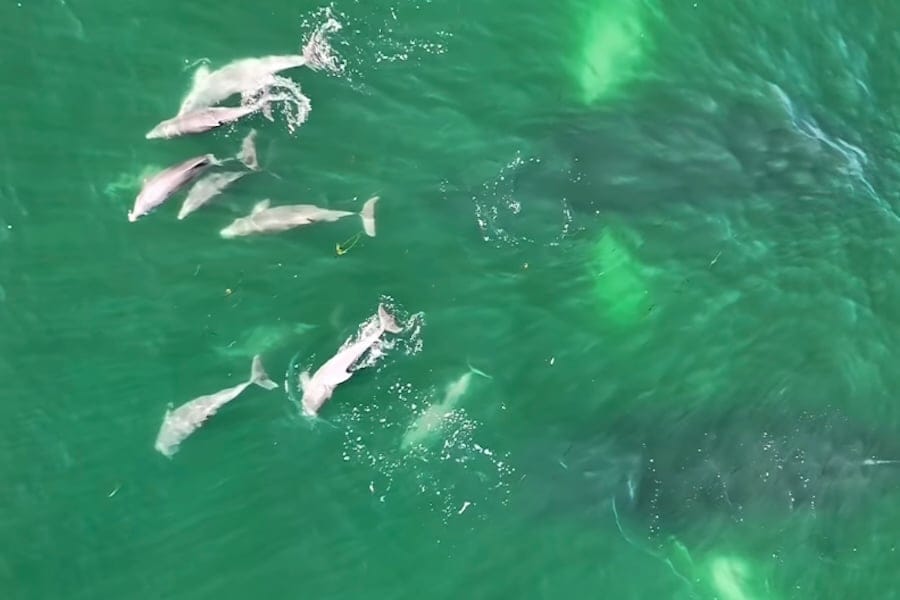
Greater East End coverage is funded in part by Peconic Bay Medical Center in Riverhead, providing world-class services to all of Eastern Suffolk. Because an extraordinary community deserves extraordinary care.
As Tumbleweed Tuesday sends summer visitors packing, the Hamptons beaches may be quieting down, but just off the coast, the ocean still teems with life.
Whales and dolphins continue to glide through the waters — their majestic movements captured in stunning drone footage by local photographers who have documented the awe-inspiring scenes all summer long.
Humpbacks are found in the greatest numbers around Long Island during the months of June through October, according to the Coastal Research & Education Society of Long Island, Inc.. Though they are present in the waters of the New York Bight — a triangular region that extends from Long Island down to the northern coast of New Jersey — throughout the year.
Warmer waters from late spring to early fall, together with an abundance of prey, attract humpbacks and dolphins closer to shore, giving photographers ample opportunities to capture their beauty.
In the video below, nature photographer Michael Busch of Great South Bay Images showcases humpback whales and dolphins, swimming together off the coast of Long Island and seemingly coordinating on a feeding hunt. The drone footage was captured over Labor Day weekend.
Dolphins and whales and tuna, oh my!
The footage below was also taken by Busch, on Sunday. It’s garnered worldwide coverage — including ABC News, Fox News and Yahoo News. In the clip, bottlenose dolphins, humpback whales and even tuna take part in a feeding frenzy on Atlantic menhaden off the coast of Fire Island.
Dodging the ropes at Hamptons beach
Hamptons nature photographer Joanna Steidle captured the stunning video below of a female humpback whale feeding just 20 yards from shore in Southampton.
The female humpback captivated surfers while lunge feeding on a massive school of menhaden just 20 yards from shore at Gin Beach in Southampton, according to Steidle.
“Beach goers were cheering in excitement as big sprays catapulted through her blow holes! She came so close to shore, I was quite concerned she might get hurt by the roped off swimming area,” she wrote in the description of her YouTube video, which was shared on Instagram by the New York Post. “Fortunately, the humpback whale just nearly missed the ropes twice along her feeding journey.”
Steidle took the video below on Aug. 25.
‘Constantly lunge feeding’
East Hampton shutterbug Sutton Lynch recorded this beauty below, featuring humpbacks feeding amazingly close to shore between East Hampton and Montauk.
“There were at least 10 whales swimming back and forth between East Hampton and Montauk, constantly lunge feeding just 20 to 30 feet from the sandbar in 10 feet of water,” Lynch wrote in an Instagram post.
Did you know?
Male humpback whales are famous for their singing. Their songs are intricate, always changing, and can last up to 30 minutes, according to the Whale and Dolphin Conservation (WDC). Every male in the same breeding area sings the same sequence of themes that year. Impressively, their songs can hit notes across 7 octaves, covering nearly the whole range of a piano.
Here are some other interesting facts from the National Oceanic and Atmospheric Administration about the whales and dolphins roaming Long Island waters:
• Not only do dolphins communicate via squeaks, buzzes, whistles and clicks that can be heard from miles away, they are also believed to send messages by slapping the water’s surface with their tails or bodies.
• Dolphins and porpoises come in all different sizes. In fact, there are dozens of species of dolphins and porpoises, including the bottlenose and common dolphins, and killer whales. Flipper, perhaps the world’s most famous dolphin, belonged to the bottlenose species.
• Humpback whales routinely make incredible migration journeys of 4,000 to 5,000 miles each way, traveling between cold water feeding grounds and warm water breeding grounds.
• Adult humpback whales are huge — ranging from 40 to 60 feet in length and weighing up to 40 tons.
• Humpback whales deploy unique feeding methods, such as bubble net feeding. The technique involves a group of whales blowing bubbles in a circle to corral fish into a tight ball. At the right moment, the whales lunge upward with their mouths open to catch the clustered prey.
Top image: Instagram still.


























